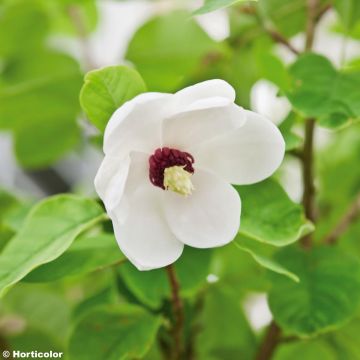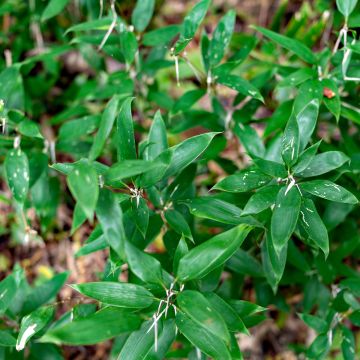

Magnolia grandiflora Mainstreet
Magnolia grandiflora Mainstreet
Magnolia grandiflora Mainstreet
Southern Magnolia, Bull Bay
I received my order on time, the young plant arrived in perfect condition thanks to the appropriate packaging and it's very well formed, thank you, it will soon find its place next to its siblings in the wooded garden.
Benoît, 09/10/2025
Special offer!
Receive a €20 voucher for any order over €90 (excluding delivery costs, credit notes, and plastic-free options)!
1- Add your favorite plants to your cart.
2- Once you have reached €90, confirm your order (you can even choose the delivery date!).
3- As soon as your order is shipped, you will receive an email containing your voucher code, valid for 3 months (90 days).
Your voucher is unique and can only be used once, for any order with a minimum value of €20, excluding delivery costs.
Can be combined with other current offers, non-divisible and non-refundable.
Home or relay delivery (depending on size and destination)
Schedule delivery date,
and select date in basket
This plant carries a 24 months recovery warranty
More information
We guarantee the quality of our plants for a full growing cycle, and will replace at our expense any plant that fails to recover under normal climatic and planting conditions.
Would this plant suit my garden?
Set up your Plantfit profile →
Description
The Magnolia grandiflora 'Mainstreet' is a cultivar appreciated for its narrow and pyramidal habit, suitable for small gardens or urban gardens. This evergreen tree also offers large fragrant white flowers, appearing from summer to autumn, as well as beautiful dark green glossy foliage with a reddish-brown underside. Resistant to cold down to -18°C, this beautiful magnolia makes a strong impression as a single specimen or in a row along a long driveway.
The Magnolia grandiflora belongs to the Magnoliaceae family. Native to the southeastern United States, the botanical species is naturally found in humid coastal forests. The 'Mainstreet' cultivar was selected for its particularly narrow and compact habit. This magnolia has a very narrow pyramidal habit, almost fastigiate, which tends to slightly round with age. It reaches about 12 to 15 meters in height and 4 to 5 meters in width. Its growth is relatively fast.
Its evergreen foliage consists of large ovate leaves, measuring between 12 and 20 cm long. They are dark green and glossy on the top, while the underside is reddish-brown, covered with a soft fuzz. The flowers, wide and open cup-shaped, measure between 15 and 20 cm in diameter. They are creamy white and diffuse a pleasant lemony fragrance. Flowering occurs from early summer to autumn, from June-July to October. This magnolia also produces upright cone-shaped fruits, containing red seeds, which appear after flowering. The trunk, straight and sturdy, is covered with smooth gray bark in the early years, becoming more fissured over time. Magnolia grandiflora 'Mainstreet' tolerates pruning well, allowing control of its development in tighter spaces.
The less bulky Magnolia grandiflora 'Mainstreet' is particularly appreciated in urban or small gardens. It can be planted in a row to border a driveway or path. Its slender habit and moderate growth will be put to good use at the back of a border or as a single specimen in a small garden. Planted against a sunny wall, it offers a magnificent summer flowering display while being protected from cold winds. To accompany it, choose Japanese Camellias with evergreen foliage that bloom in winter. It can also be paired with Cercis canadensis 'Red Force', a small tree with purple foliage and pink flowers in spring, or with Viburnum tinus 'Giganteum', for a touch of greenery throughout the year. The Abelia chinensis will complement this set nicely with its fragrant flowering that renews from summer to early autumn.
Report an error about the product description
Magnolia grandiflora Mainstreet in pictures


Plant habit
Flowering
Foliage
Botanical data
Magnolia
grandiflora
Mainstreet
Magnoliaceae
Southern Magnolia, Bull Bay
Cultivar or hybrid
Other Magnolia
View all →Planting and care
The Magnolia grandiflora 'Mainstreet' should be planted in spring, in deep, rich, fresh, consistent soil, in a good forest compost (pH 6) enriched with clayey garden soil. Pure heather soil is not recommended as it is too poor in nutrients. Clearly calcareous soils are not suitable for it. In warmer climates and mild winters, you can plant it in autumn so it can benefit from winter rainfall. It appreciates a sunny and open exposure, sheltered from prevailing winds, and will tolerate light shade further south. It is advisable to protect young plants from severe winter frosts during the first two or three years: dress them in a thick wintering veil if severe frosts are forecast, then remove it as soon as the temperatures soften a bit. The weight of the snow weakens the branches which can break, although this variety is rather less sensitive than others. As an adult, this variety proves to be quite cold-resistant, down to about -18°C. Be careful not to break the fleshy roots and not to bury the root ball too deeply. Mulch and water in summer, paying particular attention to hot and dry summers; this magnolia prefers the soil to remain fairly moist in summer. Maintain good humidity by showering its foliage with a fine spray only in the evening.
Planting period
Intended location
Care
-
, onOrder confirmed
Reply from on Promesse de fleurs
Similar products
Haven't found what you were looking for?
Hardiness is the lowest winter temperature a plant can endure without suffering serious damage or even dying. However, hardiness is affected by location (a sheltered area, such as a patio), protection (winter cover) and soil type (hardiness is improved by well-drained soil).

Photo Sharing Terms & Conditions
In order to encourage gardeners to interact and share their experiences, Promesse de fleurs offers various media enabling content to be uploaded onto its Site - in particular via the ‘Photo sharing’ module.
The User agrees to refrain from:
- Posting any content that is illegal, prejudicial, insulting, racist, inciteful to hatred, revisionist, contrary to public decency, that infringes on privacy or on the privacy rights of third parties, in particular the publicity rights of persons and goods, intellectual property rights, or the right to privacy.
- Submitting content on behalf of a third party;
- Impersonate the identity of a third party and/or publish any personal information about a third party;
In general, the User undertakes to refrain from any unethical behaviour.
All Content (in particular text, comments, files, images, photos, videos, creative works, etc.), which may be subject to property or intellectual property rights, image or other private rights, shall remain the property of the User, subject to the limited rights granted by the terms of the licence granted by Promesse de fleurs as stated below. Users are at liberty to publish or not to publish such Content on the Site, notably via the ‘Photo Sharing’ facility, and accept that this Content shall be made public and freely accessible, notably on the Internet.
Users further acknowledge, undertake to have ,and guarantee that they hold all necessary rights and permissions to publish such material on the Site, in particular with regard to the legislation in force pertaining to any privacy, property, intellectual property, image, or contractual rights, or rights of any other nature. By publishing such Content on the Site, Users acknowledge accepting full liability as publishers of the Content within the meaning of the law, and grant Promesse de fleurs, free of charge, an inclusive, worldwide licence for the said Content for the entire duration of its publication, including all reproduction, representation, up/downloading, displaying, performing, transmission, and storage rights.
Users also grant permission for their name to be linked to the Content and accept that this link may not always be made available.
By engaging in posting material, Users consent to their Content becoming automatically accessible on the Internet, in particular on other sites and/or blogs and/or web pages of the Promesse de fleurs site, including in particular social pages and the Promesse de fleurs catalogue.
Users may secure the removal of entrusted content free of charge by issuing a simple request via our contact form.
The flowering period indicated on our website applies to countries and regions located in USDA zone 8 (France, the United Kingdom, Ireland, the Netherlands, etc.)
It will vary according to where you live:
- In zones 9 to 10 (Italy, Spain, Greece, etc.), flowering will occur about 2 to 4 weeks earlier.
- In zones 6 to 7 (Germany, Poland, Slovenia, and lower mountainous regions), flowering will be delayed by 2 to 3 weeks.
- In zone 5 (Central Europe, Scandinavia), blooming will be delayed by 3 to 5 weeks.
In temperate climates, pruning of spring-flowering shrubs (forsythia, spireas, etc.) should be done just after flowering.
Pruning of summer-flowering shrubs (Indian Lilac, Perovskia, etc.) can be done in winter or spring.
In cold regions as well as with frost-sensitive plants, avoid pruning too early when severe frosts may still occur.
The planting period indicated on our website applies to countries and regions located in USDA zone 8 (France, United Kingdom, Ireland, Netherlands).
It will vary according to where you live:
- In Mediterranean zones (Marseille, Madrid, Milan, etc.), autumn and winter are the best planting periods.
- In continental zones (Strasbourg, Munich, Vienna, etc.), delay planting by 2 to 3 weeks in spring and bring it forward by 2 to 4 weeks in autumn.
- In mountainous regions (the Alps, Pyrenees, Carpathians, etc.), it is best to plant in late spring (May-June) or late summer (August-September).
The harvesting period indicated on our website applies to countries and regions in USDA zone 8 (France, England, Ireland, the Netherlands).
In colder areas (Scandinavia, Poland, Austria...) fruit and vegetable harvests are likely to be delayed by 3-4 weeks.
In warmer areas (Italy, Spain, Greece, etc.), harvesting will probably take place earlier, depending on weather conditions.
The sowing periods indicated on our website apply to countries and regions within USDA Zone 8 (France, UK, Ireland, Netherlands).
In colder areas (Scandinavia, Poland, Austria...), delay any outdoor sowing by 3-4 weeks, or sow under glass.
In warmer climes (Italy, Spain, Greece, etc.), bring outdoor sowing forward by a few weeks.


















































